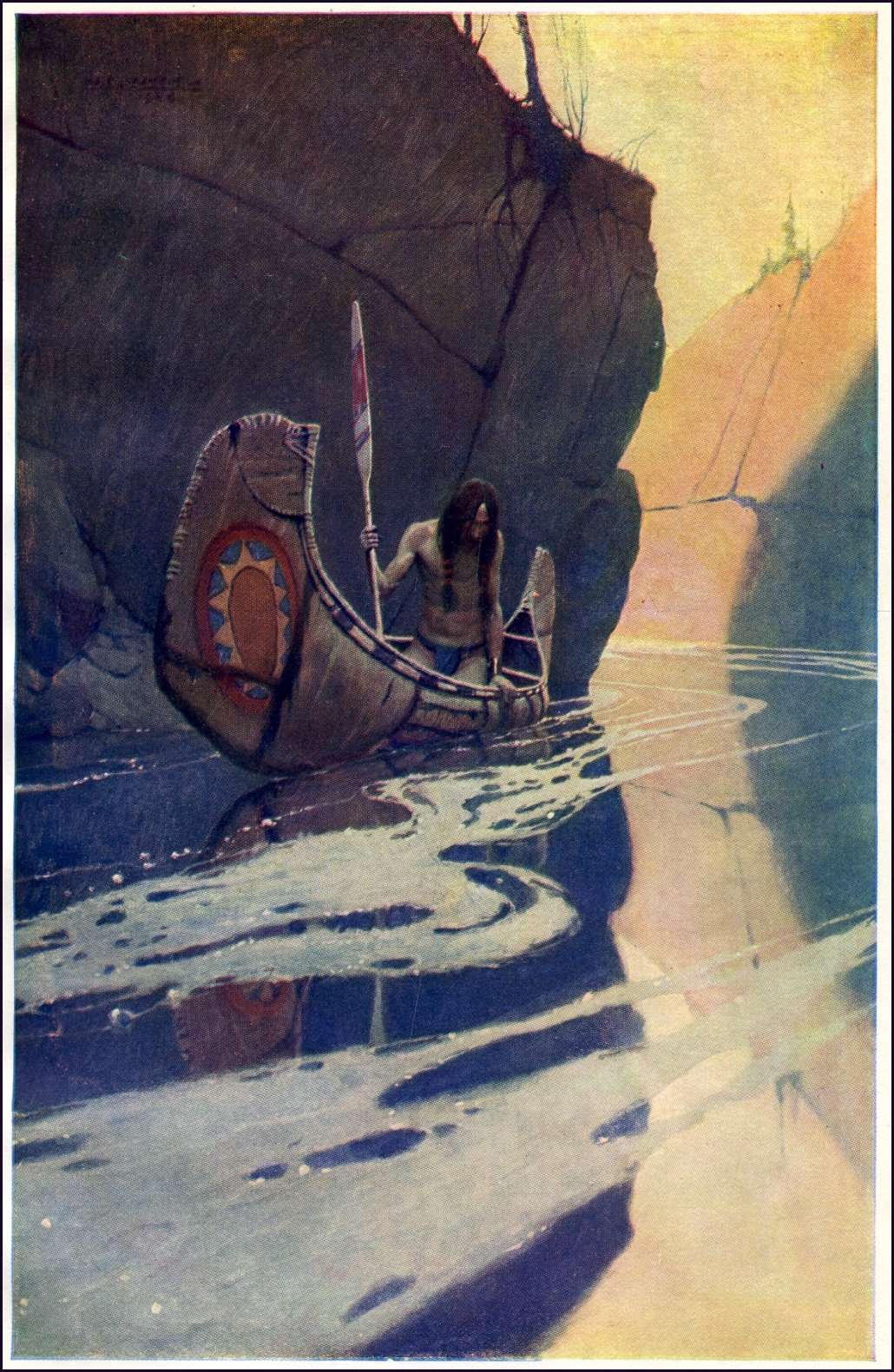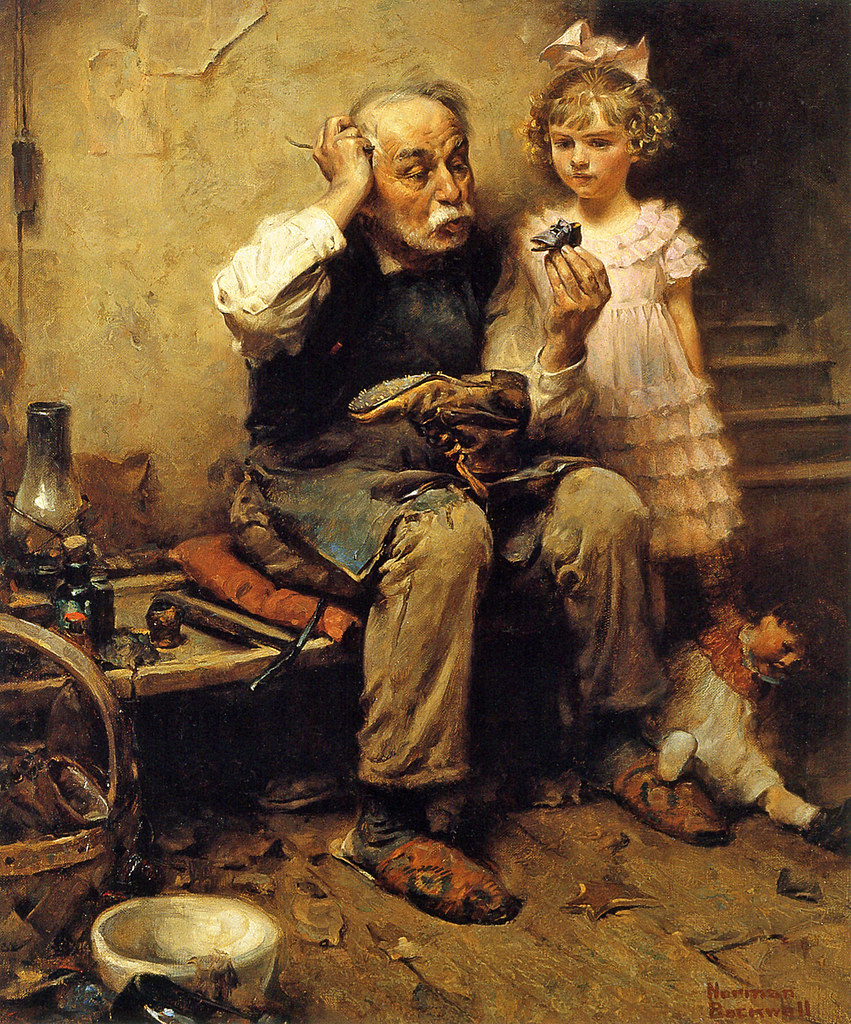 |
| NC Wyeth, illustration from Treasure Island |
The show, called "Keepers of the Flame: Parrish, Wyeth, Rockwell and the Narrative Tradition," traces teacher/student lineages going all the way back to the Renaissance.
Dennis Nolan is the curator of the show and the author of the 216-page catalog. A teacher himself for half a century, he is interested in how the skills and knowledge needed to make storytelling pictures were passed from one generation to the next.
 |
| Maxfield Parrish |
The Art Students League and the Philadelphia Academy were important schools for training American illustrators. Many teachers there had spent time in Europe under the tutelage of French academic masters.
For example, Maxfield Parrish studied under Thomas Anschutz, who was a pupil of Thomas Eakins, who enrolled with Jean-Leon Gérôme, who was taught by Paul Delaroche, who learned from Antoine-Jean Gros, who studied under Jacques-Louis David, who was in the studio of Joseph-Marie Vien.
 |
| Gerome, Bouguereau, Laurens |
It takes a lot of concentration to keep track of all the didactic genealogies, which call to mind the begetting streaks in Genesis and Matthew.
 |
| Mowbray and Benjamin-Constant |
The teacher-student lineage story leaves aside important forces that shape and define an artist. Nolan ignores other formative influences, such as the inspiration that Rockwell took directly from artists he never met, from his contemporaries, and from Modern movements.
When Rockwell listed the artists he studied in his student days and who he admired later, he didn't mention his teachers (George Bridgman and Thomas Fogarty):
"Ever since I can remember, Rembrandt has been my favorite artist. Vermeer, Breughel, Velásquez, Canaletto; Dürer, Holbein, Ingres as draftsmen; Matisse, Klee―these are a few of the others I admire now. During my student days I studied closely the works of Edwin Austin Abbey, J.C. and Frank Leyendecker, Howard Pyle, Sargent, Whistler.” (from My Adventures as an Illustrator by Norman Rockwell)
 |
| Jules-Joseph Lefebvre, The Language of the Fan |
American illustration was inclusive, inventive, popular and progressive. It embraced new technologies such as color printing, gave birth to new art forms such as comics, movies, and animation, and expressed the drama of contemporary life.
But these minor quibbles don't get in the way of appreciating the extraordinary artwork on display in this exhibition.
 |
| "The Byzantine Emperor Honorius" - Jean-Paul Laurens, 1880 |
 |
| NC Wyeth |

Nolan dedicated the catalog "to my teachers, who taught me how to be an artist, and to my students, who taught me how to be a teacher." For visitors who are either students or teachers of art, this exhibition will be particularly affirming.
-----
The catalog "Keepers of the Flame: Parrish, Wyeth, Rockwell and the Narrative Tradition"
Previously: Dennis Nolan and the Hartford Art School





Dennis Nolan responds: 'Thanks so much for covering the show in your blog, and for spending the day with me soaking in all the great paintings on view. One comment on your comments: I too was bothered by the lack of women in the exhibit and I address the exclusion and reasons in the catalogue. "The preponderance of men in the lineage trees is clear evidence of the failure of society and its educational systems to allow women into their ranks. From the birth of the Italian Renaissance to the flourishing of the French academies, few women were able to receive the same training as men, with many accomplished female artists being educated only by virtue of being related to their teachers as sisters, wives, daughters, or daughters-in-law." A detailed account of when women were allowed into the schools of Paris and America follows, siting the Americans Elizabeth Shippen Green, Violet Oakley, Jessie Wilcox Smith, and Cecilia Beaux, who became the first female art teacher hired by America's oldest art institution, the Pennsylvania Academy of the Fine Arts. Most female artists were not allowed to teach before the 20th century, and none figure into the teaching lineage of Parrish, Wyeth, or Rockwell, with the possible exception of Elisabeth Louise Vigee LeBrun whose studio was frequented by family friend Alphonse Gros (Delaroche's teacher) when he was a young child. Vigee LeBrun's education is not clearly verifiable. As a matter of coincidence, the show just north of the Norman Rockwell Museum at the Clark Art Institute launched an exhibition of the same day as Keepers of the Flame the chronicles the history of women artists in France in the late 1800's. The two shows cover a lot of academic territory and history. Thanks again for the write up Jim.'
ReplyDeleteThank you for this thoughtful review, James. It was wonderful to see you in the galleries this weekend. Thanks for coming and offering your insights.
ReplyDeleteThanks for the comprehensive overview — I especially liked the phrase “begetting streaks.” Good to read Dennis’s response, as well. It’s this kind of long form post and reply that still make the blog so valuable to me, relative to Instagram. Wish I could visit the exhibit in person — I have a particular fondness for that last N. C. Wyeth illustration.
ReplyDeleteGreat stuff on exhibition - always delightful to revisit!
ReplyDeleteTo learn about Paul Klee being included in Norman Rockwell's list of favorite artists was a surprise to me.
Dennis:
ReplyDeleteThanks for your response.
James:
Thanks for your recent reply, especially considering your burdened schedule and all the people you must wish could be replied to as well.
Tim bollent@wwu.edu